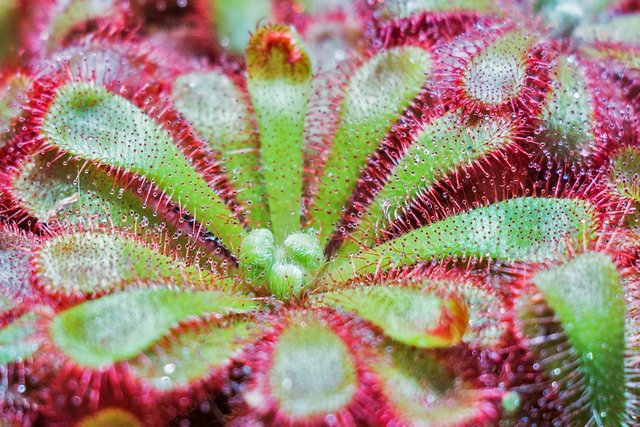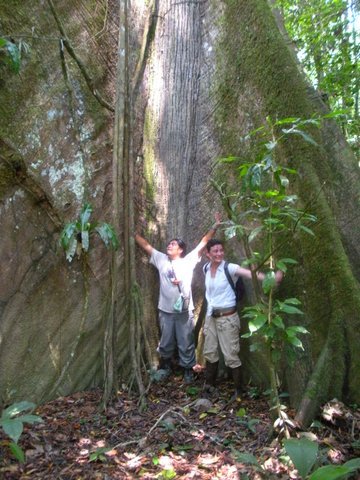Exploring Plant Consciousness & Making Music with Plants

Drosera Spatulata, a carnivorous plant,
photo by Bergadder on pixabay for public domain
I first became intrigued by the idea that plants had a consciousness when I was in my twenties. I had a very complicated operation to remove a large tumour the size of a golf ball from my nasal cavity and it was involved with the back of my throat and jaw. I had extensive surgery that left me with stitches in the back of my throat, a hole between the roof of my mouth and my nose and a small part of my jaw was removed. Consequently, my recovery meant I had to go on a liquid food diet for a year as my jaw couldn’t fully open up. Every night I would dream of sitting at a large table with a banquet of all kinds of food. While my daily routine was living off of juices and nutrient drinks, I became so detoxed I was very sensitive to energy fields and vibrations from plants to the point that I could feel the vibrational energy of an apple or a tomato get stronger if I cut it into pieces before putting it in the food blender or juicer.
Some years later, I came upon a wonderful book called the Secret Life of Plants by Christopher Bird and Peter Tomkins which was originally published in 1973, amazingly I even met one of the author's son in Guatemala years later. The book confirmed what I was feeling from the vegetables and fruits to be true energy frequencies, their reaction to my intent to use them for food. While the book itself has been referred to in the 80s and 90s as pseudoscience, today we have an entirely different perspective. Plants do feel and display an awareness of themselves and others and aside from the various interesting and sometimes horrible experiments in The Secret Life of Plants, which showed that with attached electrodes to pick up electrical signals, the plants responded energetically to other plants or insects being hurt or damaged in some way as well as to positive emotions and intent from humans.
Dr. Ashok Khosla, president of the IUCN (International Union for the Conservation of Nature) has taken this study a step further to bring people’s attention to show that all life forms have some level of consciousness and how deeply intrinsically human consciousness affects all life on this planet. He gave a public demonstration to show this with an electromagnetic experiment on plants.
How does the electro-magnetic plant device work? Based upon a device originally developed by Volney Mathison back in the 1940s, it works by using a Wheatstone bridge, which is an ultra-sensitive circuit that can detect the slightest change of electrical resistance in the plants and translate them through sounds or lights also connected to the circuit. These electrical signals may be one millionth of a volt. All living organisms, whether mammals, amphibians, or plants, have subtle electrical signals running through them. In humans, the brain communicates through the nervous system to control organs, our brains, limbs and sight, using weak electrical charges. As recounted by Peter Tompkins and Christopher Bird in their 1973 book ''The Secret Life of Plants'', several different scientists had conducted such experiments. You connect two receivers of the circuit, one to the root of the plant and the second to a leaf. They then connect the meter to a trigger, a voltage-controlled synthesiser or similar device. The change in the plant’s electrical resistance controls the pitch, volume and filtering if the measurements are translated through sound synthesis, as the plant responds to what it is sensing in its external environment and what is happening around it.
Research has found that plants react to their surroundings and they also communicate with one another. Light, water, sound, and even emotional energy within a room that a plant is placed in, all cause significant alterations to the plant’s electrical current. Each plant also has its own unique sound signature, or its own ‘song’. Now that people are beginning to understand how plants read and respond to their environment, we begin to understand that plants have a kind of consciousness as they even react to what we are going to do before we do it, or to our emotions, many experiments have shown this.
Norman Lederman was the true pioneer of reading plants that way and he put on the world's first live plant concert in quadraphonic sound, at the Kreeger Music Building's, McDonald Recital Hall back on April 17th, 1974.
Modern day research is bringing all kinds of new insights into the life of plants. Some of which can be explained in ecological relationships but it still shows that plants have a consciousness even if they are biologically different from humans and animals. For example, trees like to grow together and some of the oldest trees in the forest will have root systems that spread out for meters to carry food, nutrients and water to other younger trees, this is why it’s always important to preserve the oldest trees in the forest, much like the grandmother tree in the film Avatar. Trees in forests form communities and help younger trees grow bigger and stronger, they communicate with one another and are affected when their siblings are cut down, biologically but through their consciousness also.

Photo author's own of a Ceiba tree in the Ecuadorian Amazon, the true grandmother trees of the rain forest.
Suzanne Simard, forest ecologist at the University of British Columbia has been studying old trees in forest ecosystems and how they communicate with other trees through root systems. These ‘Grandmother’ trees transport nutrients through root systems, to younger trees when they need it. How does an older tree know when a younger tree needs these nutrients? It is a complex system of chemical communication through their roots and a giant network of fungi, some of which are mycorrhizal fungi that have a symbiotic relationship with these trees. The whole of the forest is connected by this network of fungal threads and Simard’s research reveals that when a Grandmother Tree is cut down, the survival rate of the younger members of the forest is diminished.
This interactive communicating community of trees, are not just using chemical signals, but also an awareness of consciousness, of sensing in their way, what is going on in their external environment, an environment to which they are deeply connected both biologically and on sensory levels which we are still trying to understand. This is even more reason why it is important to preserve ancient trees in forest ecosystems.
A community of people at Damanhur in Italy have been studying plants for 30 years, inspired by The Secret Life of Plants and they encourage trees and plants to play music.
Some artists have taken this work with plants a step further such as Environmental Designer Mileece from San Francisco, who combines plant music with environmental design for interactive educational projects with children.
There is some pioneering and creative research being done all over the world with plant consciousness, which will eventually help us advance our own level and understanding of the field of consciousness and our connectivity to all living beings, especially if we begin to realise that despite plants being seen as lower life forms, they respond to our thoughts and feelings as they respond to other plants and animals around them. If plants display this level of consciousness, we have not only greatly misunderstood plants, but have even more so deeply misunderstood animal intelligence, sentience and consciousness and our cruel exploitation and abuse of animals is even more unjustifiable.
by Carlita Shaw
Author of The Silent Ecocide, a crisis of human consciousness
https://www.amazon.com/Silent-Ecocide-Environmental-Crisis-Consciousness/dp/1512365718
In being barefoot in the @gardenofeden everyday, nurturing the land and playing in the garden created from free, used and recycled materials, I too know the plants have consciousness. This is a great post bringing to light a subject many people have never even thought about. I appreciate the subject and your perspective. Upvoted and followed.
I have read The Secret Life Of Plants five times cover to cover and even traveled to Sebastopol, California to meet some of the people that were written about in the book. This is an awesome post. Upvoted and I'm going to suggest it to the SteemTrail curating team for consideration.
Great article, i have one of this nice plant at home too!
Great post! In fact, it was so good that we decided to feature it in our latest newspaper. Read it here: https://steemit.com/steemplus/@steemplus/steemplus-wednesday-october-19-the-daily-newspaper-that-pays-you-to-find-high-quality-content
Poor vegitariantsy, how can they now have salads, and if plants feel? :)
But seriously, the man calling himself why the "King of nature," does not know any of his kingdom or his subjects.
This post has been linked to from another place on Steem.
Learn more about and upvote to support linkback bot v0.5. Flag this comment if you don't want the bot to continue posting linkbacks for your posts.
Built by @ontofractal
Lovely article bringing together many different types of research. And the story does not stop there! Today, there are even more interesting research studies going on to learn about plant intelligence and plant music. I study plant intelligence and interspecies communication using the Music of the Plants device. Living at Damanhur has given me an opportunity to go deep into this study, and there is still so much to learn! I am about to begin a new research study into the effects of plant music on human health, something we are extremely excited to be doing. Hope you follow our journey!